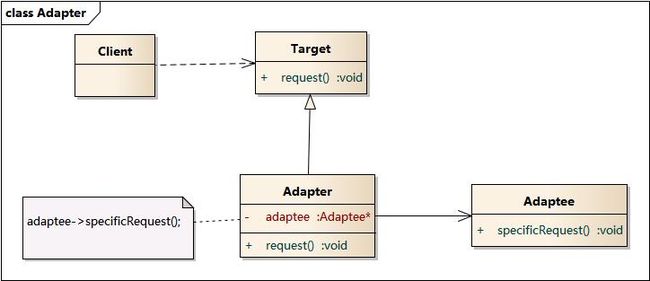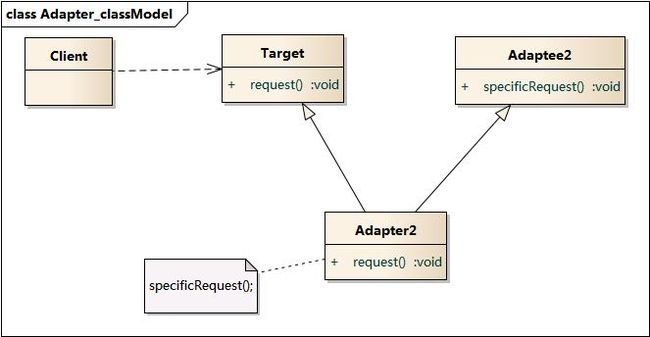设计模式——适配器模式
适配器模式
适配器模式是指将一个接口转化成另外一个希望得到的接口
适配器模式包括对象适配器模式和类适配器模式。
● 目标(Target)角色:这就是所期待得到的接口。注意:由于这里讨论的是类适配器模式,因此目标不可以是类。
● 源(Adaptee)角色:现在需要适配的接口。
● 适配器(Adaper)角色:适配器类是本模式的核心。适配器把源接口转换成目标接口。显然,这一角色不可以是接口,而必须是具体类
- 对象适配器模式如下:
对象适配器是实现适配者(Target),包含被适配者(Adaptee),当用户希望执行Target时候看,其实是通过调用Adaptee的接口。即通过被适配者的接口伪装成希望得到的适配者的接口。
- 类适配器模式如下:
而类适配器是implements适配者(Target),同时继承一个具体的被适配者(Adaptee),当用户调用Target的方法的时候,其实是调用其父类Adaptee的方法。
类适配器和对象适配器的权衡
● 类适配器使用对象继承的方式,是静态的定义方式;而对象适配器使用对象组合的方式,是动态组合的方式。
● 对于类适配器,由于适配器直接继承了Adaptee,使得适配器不能和Adaptee的子类一起工作,因为继承是静态的关系,当适配器继承了Adaptee后,就不可能再去处理 Adaptee的子类了。
对于对象适配器,一个适配器可以把多种不同的源适配到同一个目标。换言之,同一个适配器可以把源类和它的子类都适配到目标接口。因为对象适配器采用的是对象组合的关系,只要对象类型正确,是不是子类都无所谓。
● 对于类适配器,适配器可以重定义Adaptee的部分行为,相当于子类覆盖父类的部分实现方法。
对于对象适配器,要重定义Adaptee的行为比较困难,这种情况下,需要定义Adaptee的子类来实现重定义,然后让适配器组合子类。虽然重定义Adaptee的行为比较困难,但是想要增加一些新的行为则方便的很,而且新增加的行为可同时适用于所有的源
● 对于类适配器,仅仅引入了一个对象,并不需要额外的引用来间接得到Adaptee。
对于对象适配器,需要额外的引用来间接得到Adaptee。
建议尽量使用对象适配器的实现方式,多用合成/聚合、少用继承。当然,具体问题具体分析,根据需要来选用实现方式,最适合的才是最好的。
适配器模式优缺点
优点
更好的复用性
系统需要使用现有的类,而此类的接口不符合系统的需要。那么通过适配器模式就可以让这些功能得到更好的复用。更好的扩展性
在实现适配器功能的时候,可以调用自己开发的功能,从而自然地扩展系统的功能。
缺点
过多的使用适配器,会让系统非常零乱,不易整体进行把握。比如,明明看到调用的是A接口,其实内部被适配成了B接口的实现,一个系统如果太多出现这种情况,无异于一场灾难。因此如果不是很有必要,可以不使用适配器,而是直接对系统进行重构。
举例
产品需求需要得到乘法(Target)的功能,但是当前系统只有加法(Adaptee)的功能,此时采用适配器去适配。
类适配器实现
加法接口
//Adaptee
public interface IAddService {
int add(int a, int b);
}
已经存在的加法功能:
public class Adder implements IAddService {
@Override
public int add(int a, int b) {
return a + b;
}
}希望得到的乘法接口
//Target
public interface IMultiplyService {
int multiply(int a, int b);
}适配器实现:实现目标接口,继承已有类
//Adapter
public class MultiplyAdapter extends Adder implements IMultiplyService{
@Override
public int multiply(int a, int b) {
int n = Math.abs(b);
int sum = 0;
for(int i = 0; i < n; i++){
sum = add(sum, a);//通过加法功能去代替乘法实现
}
if(b < 0){
sum = -sum;
}
return sum;
}
}
测试类适配器
public class TestObjectAdapter {
public static void main(String args[]){
MultiplyAdapter adapter = new MultiplyAdapter();
System.out.println("3 x 4 = " + adapter.multiply(3,4));
System.out.println("-3 x 5 = " + adapter.multiply(-3,5));
}
}
log输出:
3 x 4 = 12
-3 x 5 = -15对象适配器实现
adaptee 功能接口:
public interface IAddService {
int add(int a, int b);
}目标接口:
public interface IMultiplyService {
int multiply(int a, int b);
}
适配器:
public class MultiplyAdapter implements IMultiplyService {
private IAddService mAdder;
public MultiplyAdapter(IAddService adder) {
mAdder = adder;
}
@Override
public int multiply(int a, int b) {
int n = Math.abs(b);
int sum = 0;
for(int i = 0; i < n; i++){
sum = mAdder.add(sum, a);//通过已有加法实现乘法
}
if(b < 0){
sum = -sum;
}
return sum;
}
}
测试:
public class TestObjectAdapter {
public static void main(String args[]){
MultiplyAdapter adapter = new MultiplyAdapter(new Adder());
System.out.println("3 x 4 = " + adapter.multiply(3,4));
System.out.println("-3 x 5 = " + adapter.multiply(-3,5));
}
}
输出:
3 x 4 = 12
-3 x 5 = -15
